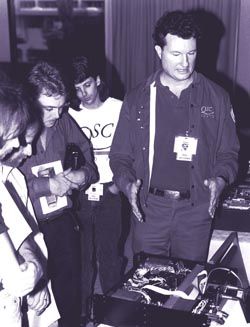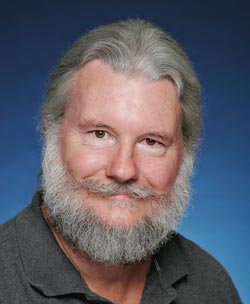Editor's Note: This month in SCN we are introducing a new feature focused on the many brilliant icons who have made our industry what it is today. The electronic systems integration business is a rare one where people's passions lead to innovation, and their personalities are as much a part of the trade as any spec sheet.
The faces and voices of these leaders are familiar, and their experience can teach us something about business, life, and the place where those two worlds overlap. These interviews are designed to open the discussion up to technical breakthroughs and words of advice from the individuals who continue to lead us in a changing business climate. Enjoy.
SCN: What was different about amps "imported from Southern California"?
Pat Quilter: "California Culture" developed in some interesting directions in the last half of the 20th century. Glamorous leading-edge industries such as aviation and Silicon Valley led the way, but there was a lot of creative activity at a somewhat more local and artistic level. The recording industry created a demand for musical electronics, and creative people such as Leo Fender responded with a combination of forward-thinking, functional style supported by down-to-earth manufacturing technology. And Disney triumphantly expanded the possibilities for making dreams come true. All this creative activity supported an infrastructure of new materials, specialty fabricators, and a general "can do" attitude.
The benign California climate encouraged informality in dress and manners, which ironically meant that you actually had to deliver the goods if you wanted respect. So summing this all up, our goal was to cut away the non-essentials, focus on getting the job done in a straightforward and unpretentious manner, and bring good products to market with some degree of style.
SCN: As the installed sound industry expanded, how did your product development change?
PQ: Our focus on essentials had produced a basic understanding of our craft. Our products were simple, producible, and worked well. However, the installed sound industry needs more proof-of-performance, since installers and consultants need to document that their recommendations are sound. This caused us to develop more formal product-testing programs, which enabled us to move into more complex technology without losing our reliability.

- Pat Quilter founded the Quilter Sound Company in 1968 in a 400-square-foot rented garage.
- PQ: When we entered the business, in 1968, we were seeing the tail end of "single brand systems". In the '50s, customers bought complete Altec, Bogen, or Dukane systems from authorized contractors, who were expected to understand their systems and handle all troubleshooting. The '60s and '70s saw the advent of the single-product specialist, such as Crown, BGW, Crest (and of course QSC) in amplifiers, JBL, EV, and EAW in speakers, plus the various console and analog processor specialists. By focusing relentlessly on one product type, these companies advanced the state-of-the-art much more aggressively than the full-service outfits. The installer's job was to cherry-pick the best of each type, and integrate them into complete systems. This involved a definite level of skill, but was a reasonable challenge, because the various components interfaced using well-standardized speaker and line-level connections. Really, the only chronic problems were ground loops, and finding the most reliable producers of each type product.
- During the '90s, digital products and networks began to add a whole new dimension to system capabilities. Unfortunately, this also entailed a whole new dimension of troubleshooting. At the same time, various companies perceived that they had reached the limits of growth in their particular category, and began to look for other expansion opportunities. These factors are driving a current trend back towards consolidation and complete system solutions. Given the incredible complexity of current software and digitally-based products, it becomes almost essential for a single supplier to take complete responsibility for the overall performance and reliability of the system. Otherwise, you get into the all-too-familiar nightmare of finger-pointing and passing the buck.
- QSC, of course, is actively competing in this new arena. We have made large ongoing investments to develop digital and loudspeaker expertise, to complement our well-known amplifier technology. Our vision is to become the most trusted provider of advanced audio technology.
Early QSC products included the Quilter Sound Thing and the Pignose Amp.
SCN: How would you finish the following sentences?
When I started Quilter Sound Company in a rented garage in 1968, I thought... that we would quickly become a force to be reckoned with in guitar amplifiers. There was a legitimate market opportunity, but we were too green to really compete, and we simply missed the boat! Luckily, we ended up recycling the best of our hard-won knowledge into the field of rack-mount power amps, which became a stable product category that supported decades of growth.
I never expected... that our operation would become as sophisticated and automated as it has. My vision more-or-less encompassed "more benches with more workers" if the business ever took off. Fortunately, some very dedicated production specialists joined our team as we grew. Their vision of "doing things right" enabled us to improve quality while saving money in the long run.
I'd strongly recommend... that you pursue your dream, but make sure you've got some experience on your side before going off on your own. All of the senior partners in QSC were new to the game, and it took us seven years of fumbling and simply trying to stay afloat before we had learned even the basics of running a business.
My motto has always been... understand the fundamental issues, get to the root cause, and the solution will become apparent.
The best advice I ever received was... from a creditor who came to check up on us during one of our early low spots. We had just spent the last of our money to build a small run of guitar amplifiers that I came to realize just didn't really have the qualities I wanted. I thought they were worthless. He asked if they at least worked and played, which they did, and they featured name-brand speakers that had value. Would they move if we sold them at cost? I supposed they would, but how would we make a profit? He pointed out that we had already spent the money to build them, and our choice at this point was either write them off completely, or settle for just getting that money back so we could move on. We marked them down ruthlessly, they did sell, and we were able to produce a newer generation of better product. This is a classic case of getting over the "sunk cost" fallacy. When you realize you've made a mistake, you've got to focus on what you can do going forward. Don't get trapped by trying to salvage prior decisions.











